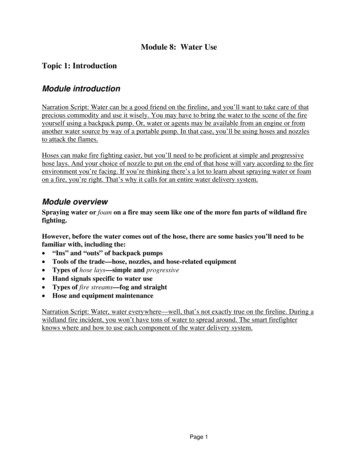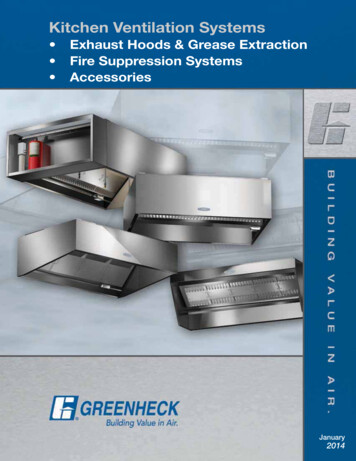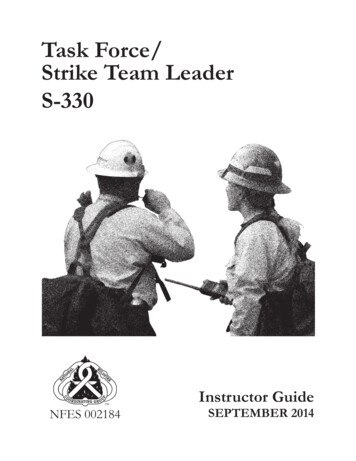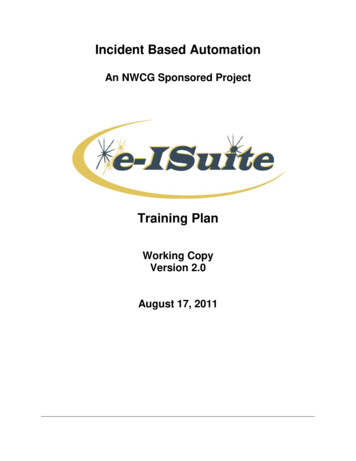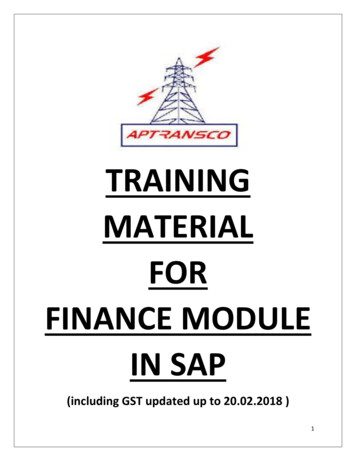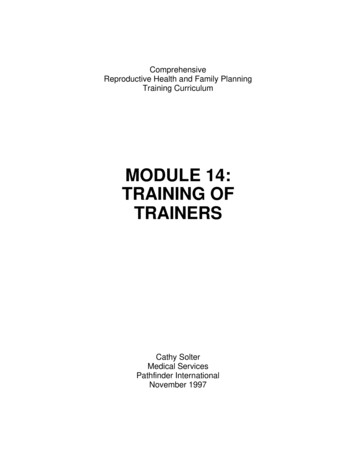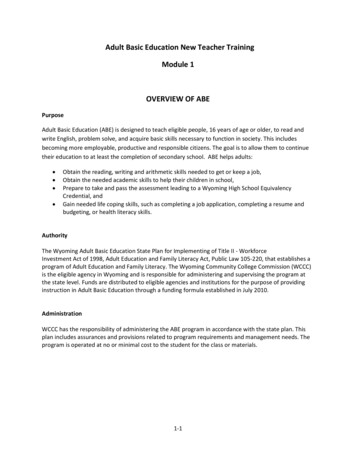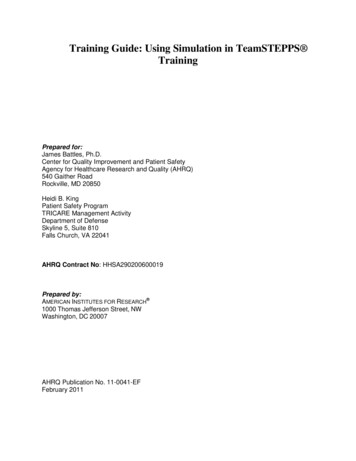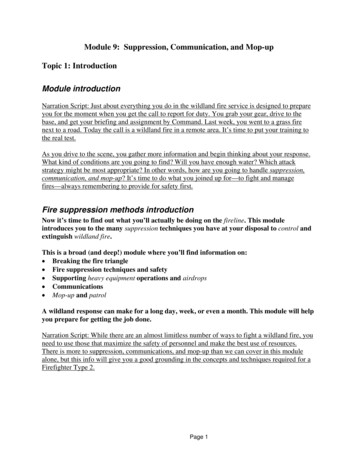
Transcription
Module 9: Suppression, Communication, and Mop-upTopic 1: IntroductionModule introductionNarration Script: Just about everything you do in the wildland fire service is designed to prepareyou for the moment when you get the call to report for duty. You grab your gear, drive to thebase, and get your briefing and assignment by Command. Last week, you went to a grass firenext to a road. Today the call is a wildland fire in a remote area. It’s time to put your training tothe real test.As you drive to the scene, you gather more information and begin thinking about your response.What kind of conditions are you going to find? Will you have enough water? Which attackstrategy might be most appropriate? In other words, how are you going to handle suppression,communication, and mop-up? It’s time to do what you joined up for—to fight and managefires—always remembering to provide for safety first.Fire suppression methods introductionNow it’s time to find out what you’ll actually be doing on the fireline. This moduleintroduces you to the many suppression techniques you have at your disposal to control andextinguish wildland fire.This is a broad (and deep!) module where you’ll find information on: Breaking the fire triangle Fire suppression techniques and safety Supporting heavy equipment operations and airdrops Communications Mop-up and patrolA wildland response can make for a long day, week, or even a month. This module will helpyou prepare for getting the job done.Narration Script: While there are an almost limitless number of ways to fight a wildland fire, youneed to use those that maximize the safety of personnel and make the best use of resources.There is more to suppression, communications, and mop-up than we can cover in this modulealone, but this info will give you a good grounding in the concepts and techniques required for aFirefighter Type 2.Page 1
Topic 2: Breaking the Fire TriangleFire triangle introductionMaybe you never thought you’d be using the laws of chemistry and physics when you gotinto the wildland fire fighting business, but that’s exactly what you’ll be doing whenworking to bring a fire under control.In this topic, you’ll put on your science hat and refresh your memory on some key aspectsof fire behavior including: Fire triangle components Breaking the fire triangleNarration Script: Believe it or not, fire management is as much science and smarts as it is muscleand brawn. However, unlike the controlled atmosphere of the classroom lab, you’ll be outdealing with the real thing, so you better understand how it works! This topic will cover the allso-important basics of the fire triangle and aspects of the combustion process. If you have gonethrough the Introduction to Wildland Fire Behavior Course—or S190—this should be a quickreview for you.Fire triangleFire is actually a by-product of a larger process called combustion. In order for combustionto take place and produce fire, three ingredients are necessary: Oxygen Heat FuelThese three ingredients are the base for what firefighters call the fire triangle.Read the following to review your knowledge of the fire triangle.Oxygen SourcesWildland fuels have an abundant supply of oxygen available in the air. A concentration ofapproximately 16 percent oxygen is required for combustion, but normal air contains 21percent—more than enough for combustion to occur. In addition, some fuel materialscontain sufficient oxygen within their makeup to support burning.Rapid oxidation occurs in two forms: Smoldering fires—ones that burn without flame and are barely spreading Steady-state fires (unchecked rapid burning)—steady-state fires are sometimes calledfree-burning firesPage 2
Heat SourcesHeat sources sufficient to reach ignition temperature may come from: Open flame Sun Lightning Hot surfaces Sparks and arcs Friction Chemical action Electric energy Compression of gasesFuel and Its Physical StateFuel may exist in any of the three states of matter—solid, liquid, and gas. However, onlygases burn. The initiation of combustion of a solid or a liquid fuel requires its conversioninto a gaseous state by heating. During combustion, heat and chemical changes in the fuelcause fuel gases to evolve from the fuel. So, even though fuel and oxygen are present in thewildland, heat must be added to liberate the fuel gases and initiate the combustion process.Fuels in Gas FormGas fuels can include: Natural gas Propane Butane Hydrogen Acetylene Carbon monoxideFuels in Liquid FormLiquid fuels can include: Gasoline Kerosene Turpentine Alcohol Cod liver oil Paint Varnish Lacquer Olive oilPage 3
Fuels in Solid FormSolid fuels can include: Dust Coal Wood Paper Cloth Leather Plastic Sugar Grain Hay CorkNarration Script: Let’s start with a basic concept the fire triangle. There are lots of fuels—trees,branches, brush—in wildland areas, and fuel is obviously the foundation of the triangle. Fuelmay exist in any of the three states of matter, but only gases burn. This means heat is required forfuel gases to form from wood and the other solid fuels you might find in the wildland. So, eventhough fuel and oxygen are present, heat must be added to free the fuel gases and begin thecombustion process.Caption: The fire triangle represents the three components required for a fire.Page 4
Breaking the fire triangleYou can control the combustion process (and extinguish the fire) by disrupting orremoving one or more of the three required elements of the fire triangle. In other words: Remove fuel Remove oxygen Remove the heat energyRead below about each method for more information.Remove FuelSeparating fuels or clearing a space of all surface fuels down to mineral soil (dirtcontaining little or no organic material) is a common way of controlling and extinguishingwildland fires. This is the basic idea behind the creation of any fireline.Remove OxygenWildland fires burn in the open air; therefore, attempting to restrict the oxygen supply to afire (removing oxygen) is usually limited to smothering relatively small fires with dirt. Ofcourse, make sure the dirt you use doesn’t have a lot of flammable organic material in it,such as pine needles and dead leaves.Remove the Heat EnergyRemove heat by applying water, dirt, retardant, or a combination of these. Cooling the firewith water or Class A foam is one of the most common and effective fire extinguishingmethods. You can also remove heat during night mop-up by chunking the fuels, allowingthem to burn down, and then spreading the hot materials to expose them to the cooler nightair.Narration Script: You figure it out—if fire requires fuel, oxygen, heat, how would you go aboutbreaking the fire triangle and controlling the combustion process?Page 5
Knowledge Check 1Matching—select the match you choose from the pull down list.Usually you try to avoid breaking things, but when it comes to controlling combustion in awildland fire, breaking the fire triangle is the right thing to do.Match each way to break the fire triangle to the BEST method. You may use the steps tobreak the fire triangle more than once.Remove fuelRemove oxygenRemove heatRemove heatSpray with Class A foamSpray with Class A foamSpray with Class A foamSpray with Class A foamThe correct matches are as follows:Remove fuel: Construct a firelineRemove oxygen: Smother with dirtRemove heat: Spray with waterRemove heat: Spray with Class A foamTopic summaryIn this topic, we gave you some basic fire concepts—most likely a welcomed refresher fromyour Introduction to Wildland Fire Behavior (S-190) course. We identified: The fire triangle Breaking the fire triangleUnderstanding the principles behind the fire triangle is one ally in your pursuit of a wellmanaged fire.Narration Script: A wildland fire has a seemingly endless supply of oxygen and an abundance offuels to keep it going. The good news is that your brain will now easily identify the parts of thefire triangle keeping the blaze going—and now, perhaps the more challenging news is the needto put your muscles to work as you begin to break up the fire triangle and control the fire.Page 6
Topic 3: Suppression and SafetyTopic introductionIf you’ve gone through this course in the order it has been presented, we’ve discussedeverything from tool use to how you’ll travel to an incident. Now it’s time to find out whatyou’ll actually be doing on the fireline. This topic introduces you to the many suppressiontechniques you can use to control and manage wildland fires.In this topic, you’ll discover such techniques as: Fire attack methods Suppression techniques Control lines Water use Wet linesNarration Script: While there are countless ways to fight wildland fires, you want to use thosethat maximize the safety of firefighters and make the best use of available resources. There ismore to suppression than we can cover here, but this topic will give you a good start towardunderstanding the strategies and techniques required to successfully control and managewildland fires.Fire control tactic factorsThe suppression tactics implemented during initial attack will be based on the location ofthe fireline in relation to the flame front. The tactics are forms of either direct or indirectattack that may be used singly or in combination with each other.When deciding the tactics to use in a particular situation, Command will take into account: Actual or potential life hazards Exposures—threatened property or resources Fuel types, moisture, continuity, and arrangement Current and expected weather, including temperature and especially wind Topography Anchor pointsNarration Script: If you’ve gone through the modules in the course in order, you should now befamiliar with how you will use water and hand tools in fire suppression. Therefore, it is time totalk about the suppression tactics you will follow.As an entry-level wildland firefighter, it’s not your responsibility to determine fire control tacticsduring an initial attack, BUT you will be an active participant, and it doesn’t hurt to know theresponsibilities of the people above you. A well-planned initial response controls about 90percent of all wildland fires. To ensure each incident you participate in falls within these odds,supervisors will determine the right fire-control tactics after a thorough scene size-up.Page 7
Direct vs. indirect attackWhen you respond to a wildland scene, your incident commander (IC) will assess conditionsand determine the best way to attack the fire. Your job is to implement the chosen strategy.To understand how you fit into the big picture, learn the two primary attack methods usedon wildland fires: Direct IndirectYou will investigate each method in turn.Narration Script: Understanding the two primary attack methods—direct and indirect—will giveyou a better idea of how you fit in to the overall suppression effort.Direct attackIn a direct attack, the IC determines if personnel and resources can safely work against theflames directly. One of the primary determining factors in direct attack is flame lengths.Normally, flame lengths of less than 4 ft. (1.2 m) can be fought directly with hand tools andhandlines. When working in this manner, keep one foot in the black and one foot in theunburned area. Flames up to 8 ft. (2.4 m) require heavy equipment or airdrops.Some common direct attack techniques include: Smothering or removing fuel with hand tools Spraying water in stationary or mobile attackWarning—Working from the GreenSome direct attacks can be performed from the green. However, any time you participatein an attack from the green, LCES must be in place! In these cases, make sure eachfirefighter knows where the escape routes and safety zones are located. Don’t fall into“Watch-Out!” Situation 3—safety zones and escape routes not identified.Narration Script: As you might expect, in a direct attack you bring personnel right up to the fireedge. If you can safely attack a fire directly, you may be sent into action with hand tools toremove fuels and smother burning fuels, handlines to knock down flames, and engines withpump-and-roll capability in one or more types of mobile attack.Indirect attackWhen flame lengths exceed 8 ft. (2.4 m), direct attack of any kind becomes impractical. Inthis situation, indirect attack is the only option.Indirect attack requires firefighters to build control lines, either by hand, with mechanizedequipment, with water (wet line), or by using existing natural or man-made barriers. YouPage 8
then burnout or backfire fuels between the control line and the oncoming fire edge. On largeincidents, you may be miles from the actual fire edge. On smaller incidents, you may bevery close to the flame front.Narration Script: When a fire is too intense for you to go up against it directly, your IC’s onlychoice is to pick a safe spot you can defend, build a control line, and then start removing fuelsfrom the fire’s path. This method sacrifices a certain amount of vegetation or other values, suchas structures, but it is often the only option. You will learn more about building control lines andfiring operations later in this topic.Flank attackAnother tactic for fighting wildland fires is the flank attack, also referred to as a flankingattack or flanking the fire. The flank attack is used for moderately intense fires moving at amoderate rate of spread (ROS).Here’s the skinny on flank attacks: Start a flank attack at a secure anchor point on one or both flanks of a fire, and worktoward the head Attack the flanks directly or indirectly—the distance of the control line from the fireedge usually depends on fire intensity Attack the flanks simultaneously or successively, depending on fire conditions andresources available Aircraft can be one of the flank-attack resources when necessaryConsider these safety concerns when performing a flank attack. Burn out the strip of unburned fuel between the line and the fire’s edge as soon aspossible during fireline construction Work in the black whenever possible—however, if lives or structures are at risk, yourcrew may have to attack from the green if they can do it safelyNarration Script: We’ll cover flank and parallel attacks next. These kinds of attacks can usedirect or indirect strategies. Flank attacks work best for moderately intense fires moving at amoderate rate of spread. They’re also the best alternative if a fire is too intense for a frontalattack with ground resources.Parallel attackOccasionally, you may need to fight a wildland fire using a parallel attack. When applyingthe parallel attack strategy, timing is everything. A control line is constructed as near to thefire’s edge as possible while still allowing enough time to complete the line before the firefront arrives. For this reason, parallel attacks often employ mechanized equipment, such astractor-plows and bulldozers, because the line can be constructed more quickly.Page 9
The parallel attack is similar to an indirect attack, but the control line is constructed muchcloser to the fire’s edge, usually within 100 ft. (30 m). The area sacrificed to the fire issmaller than in an indirect attack.Narration Script: The parallel attack is a chip off the old block to the indirect attack. Thedifference between the two is in the choice of tools to build the line. Parallel attacks often consistof mechanized equipment. Because bulldozers and tractors can build a line so much faster than ahand crew, the control line is constructed much closer to the fire’s edge than in an indirect attack.When to use a parallel attackA parallel attack reduces the labor of hand crews because a line can be constructed straightacross indentations of the fire front, thus shortening the line. When performing a parallelattack, the area between the control line and the fire is usually burned out as the workprogresses, or firefighters patrol the line to ensure that it is not breached when the mainfire reaches it.Use a parallel attack: Whenever a fire is too intense for direct attack When a fire’s edge is so irregular that direct attack would result in an excessively longcontrol line To keep the fire away from heavy fuels To encircle spot firesKnowledge Check 2Matching—select the match you choose from the pull down list.Match each attack method to the appropriate situation or technique. You may use eachattack method more than rately intense fire moving at moderate ROSModerately intense fire moving at moderate ROSModerately intense fire moving at moderate ROSModerately intense fire moving at moderate ROSModerately intense fire moving at moderate ROSModerately intense fire moving at moderate ROSThe correct matches are as follows:DirectShort flame lengthsDirectSmotheringIndirectLong flame lengthsIndirectLine construction far from the fire edgeFlankModerately intense fire moving at moderate ROSParallelEncircling spot firesPage 10
Suppression techniques introductionOnce your supervisor or IC makes the initial decision whether the overall strategy will be adirect, indirect, flank, parallel, or combination attack, you may use a variety of techniquesto suppress and extinguish wildland fires. Depending on the attack strategy and otherfactors, some of the techniques you’ll use are: Hotspotting Cold trailing Building scratch lines Fireproofing fuel Firing operations Building cup trenchesYou will examine each technique in this order.Narration Script: Of course, when selecting the most appropriate suppression techniques, youmust always consider firefighter safety first. You’ll have to weigh your knowledge ofsuppression techniques with the situation you’re in. So, while hotspotting and cold trailing mightbe safe and effective in some cases, they may not be in other situations. Until you are welltrained and educated, your crew boss and IC will help you make those decisions—but bedecisive and ask questions when you feel unsure of an assignment.HotspottingHotspotting involves making a rapid attack on the hot-burning points of a fire’s edge, suchas rapidly developing fingers or other active parts of a fire that are threatening life or highvalue property. Hotspotting is done prior to constructing control lines and is one of themore dangerous tactics because it is not initiated from an anchor point. Hotspotting isusually done by any available resources (with the proper experience) and should be donefrom within the black or by taking advantage of other natural barriers.Narration Script: For the linguists in the crowd, you might surmise that hotspotting is the act oflooking for hot spots and you’re right. Hotspotting allows firefighters building firelines to getclose enough to attack the fire directly by cooling the fire’s edge. Certain areas of the firelinemight be hotter than others, and by hitting these areas early enough to slow the ROS, hotspottershelp prevent the fire from “making a run.”Hotspotting is NOT for the inexperienced firefighter and even falls under the umbrella of WatchOut Situation number 8, because hotspotting is done without the safety of an anchor point.Hotspotting is done only after careful evaluation by a supervisor and, of course, with an eye onthe appropriate LCES.Cold trailingFirefighters cold trail to try to improve their control of a partly dead fire edge by checkingfor hot spots and widening the line or cutting a new one if necessary. Cold trailing involvesPage 11
carefully inspecting and feeling with bare hands to detect any fire, digging out andextinguishing every hot spot, and even building new fireline around any live edges.Narration Script: Cold trailing isn’t actually “cold” at all. When firefighters cold trail, theyinspect a fire edge looking for hot and still-burning areas, digging them out, and even diggingnew firelines if necessary.Scratch lineWhen time is of the essence, you’ll build a scratch line—and fast. A scratch line is apreliminary contro
Page 1 Module 9: Suppression, Communication, and Mop-up Topic 1: Introduction Module introduction Narration Script: Just about everything y
